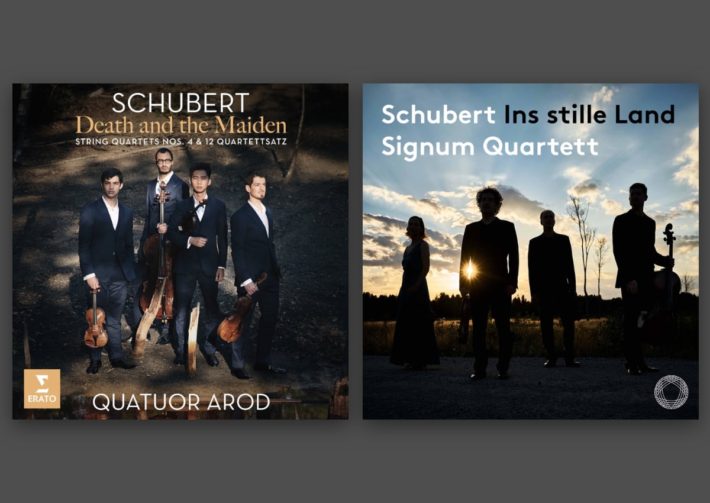These new releases by Pentatone and Erato show two quartets combining familiar and unfamiliar works by Schubert. The Signum Quartett presents a second volume of sorts, after releasing a similar concept album in 2018, attaching two early and late String Quartets with arrangements of songs by Schubert. For Quatuor Arod, this is a first Schubert recording after fine albums of music by Mendelssohn and the Second Viennese School.
Quatuor Arod Schubert album on Amazon
Signum Qurtett’s Schubert album on Amazon
Reviewing The Chiaroscuro Quartet’s performance of the “Death and the Maiden” Quartet (see here), I mentioned that there always seems to be two extreme approaches to the piece – The energetic, swift and sometimes rough approach (The Lindsays, Takács and Pavel Haas quartets), and the more inward, aristocratic, clear-headed approach (Quartetto Italiano or Alban Berg quartets). Quatuor Arod clearly belongs to the former. The opening chord is dramatic, almost violent, as well as some of the second movement’s louder segments. There’s tenderness as well, and when used it maintains a suspenseful tension, as in the more dreamy sections of the first movement.
Although rough at the edges, Quatuor Arod project a good blend of instruments, with the first violin knowing when to break to solos, the cello giving a deep foundation to the sound of the middle instruments, which provide full and round support. This is not fully “historically informed” performance; the players are using the full capabilities of their instruments and bows, the vibrato is considered but omnipresent and dynamic range truly incapsulates everything from the quietest pianissimos to the loudest fortissimos.
Quatuor Arod also follow the score carefully but somehow never sounds studied. The end of the D Minor show an almost complete abandonment of caution, as if on the brink of losing sanity. From recent versions, the Arod’s has the most in common with the Novus Quartet and Vision Quartet (see review of the latter here), but mostly, possesses a sound of its own. Overall, an exciting and impressive performance of this often-recorded work.
Related Classical Music Reviews
- Review: “Memento” – Vision String Quartet Play Schubert and Mendelssohn
- Review: Schubert Death and the Maiden Quartet and D. 173 – The Chiaroscuro Quartet
- Review: “‘Tis Too Late To Be Wise” – Kitgut Quartet
The Arod also excel in the one-movement “Quartettsatz” – the first violin runs and pointed sforzatos of the group are particularly impressive – and give a good case for the early String Quartet D. 46. The final movement is especially enjoyable, when the quartet is sensitive to the German dance elements (track 14, 1’30). Admittedly, this is not pristine Schubert, but this performance lifts its qualities in a highly enjoyable rendition.
It’s a bit of a mistake to jump straight to the “Death and the Maiden” quartet when listening to the Signum Quartett’s new album, named “Ins stille Land”. The carefully built program follows the relationships between Schubert’s prolific song output and his early to late string quartets. The group sequences the songs and quartets so that the late D Minor is coming late in the program, and so we can follow the composer’s remarkable artistic progression in the field. The surrounding songs give us additional context to the same musical mind that created both Lieder and chamber works.
Unlike Quatuor Arod, the Signum Quartett very much follow the “historically informed” practices – the group’s dynamic range is much more subtle, the general volume is lower and the overall blend more transparent, with discernible vibrato. The qualities of this “Death and the Maiden” version are less immediately apparent on first listen, especially when coming from he Arod’s tumultuous performance. This version is more reserved, and occasionally gives a sense of daunting loneliness (the second subject of the first movement, track 11, 2’00”). There’s also a sense that the first violin is less inclined for soloistic showmanship and that the synchronisation between instrument, though not necessarily better than the Arod’s, is well considered.
The Signum Qaurtett’s players are at their best in the slow and quiet segments, which hold special concentration – the variations’ theme is a good example, as well as the Haydn-like slow movement of the early String Quartet, D. 74. After few listening sessions, I came to appreciate their tender and inward-looking performance of the String Quartets, as well as their clever way of storytelling through the song arrangements.
Both releases are well recorded and the balance suites each group’s interpretation. The Signum Quartett’s booklet contains a fuller article by Charles Fisk that expends on the album’s concept. The Arod’s booklet contains only a short assay signed by the quartet, with some attractive images.

Schubert – String Quartets No. 4, 12 and 14 (“Death and the Maiden”)
Quatuor Arod
Erato / Warner Classics, CD 9029517247
“Schubert: Ins stille Land”
Signum Quartett
Pentatone, CD PTC5186732
Quatuor Arod Schubert album on Amazon
Signum Qurtett’s Schubert album on Amazon
Recommended Comparisons
Read more classical music reviews or visit The Classic Review Amazon store
Follow Us and Comment:
[wd_hustle id=”HustlePostEmbed” type=”embedded”]











